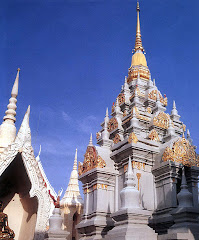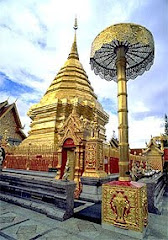 |
King Rama V
The reign of King Rama V, formerly called Phra Chula Chom Klao, began in the year B.E. 2411 and lasted 42 years. He was also one of the few monarchs who temporarily renounced his throne after his coronation in order to be ordained as a bhikkhu. This was because most of the Thai kings since Ayudhya period were usually ordained before the coronation day.
Being no less devout to Buddhism than his predecessors, he managed to found two Buddhist Universities for the sake of increasing the progress and stability of the education of Buddhism.
These two were Mahamakuta Raja Vidyalaya and Mahachulalongkorn Raja Vidyalaya, both of which have played a very in the field of Buddhist study. He also enacted a law concerning the administrative system of the community of bhikkhus, declaring that the Buddhist Church should be self-governing holy community, while the state would be the patron under the direction and for the welfare of the Church. Of other major construction work one is Wat Benjamabophit, which is well known among foreigners for its impressive Buddha image in the Uposatha.
In B.E. 2431 a Council of Bhikkhus under the chairmanship of the Supreme Patriarch Prince Pavares Variyalongkorn was held for the purpose of transliterating the existing Tipitaka from the palm-leaf books in Cambodian characters to printed books using Thai characters. This required 39 printed volumes for each set of the entire Tipitaka. Besides the Message itself, some Commentaries from Cambodian to Thai characters and then printed in the form of paper books.
One of the king’s elements of religious success, however, undoubtedly comes from the zealous efforts of one of his great helpers. This was no other than his own half-brother, the Supreme Patriarch Prince Vajirananavarorasa, who had a profound knowledge in English as well as Pali and Sanskrit. Thus, by virtue of his ability plus his high position (as the king’s brother and as chief of the whole community of bhikkhus), the theoretical and practical sides of Buddhism under the far-sighted and able Patriarch were greatly encouraged. Most of his noble works are still now studies by the public as well as by the students, and it is never an over-estimate to say that he has blazed a trial for modern thought in the study and practice of Buddhism.
In B.E. 2437 the Mahamakuta Raja Vidyalaya, one of the two Buddhist Universities published a religious periodical, called “Dhama Cakshu”, which now reaches its sixty-third anniversary and is therefore the oldest and most long-lived religious periodical in Thailand.
Technorati tags : Ratanakosin Period /Thailand Temple /Buddhism /thai temple /Bangkok









No comments:
Post a Comment